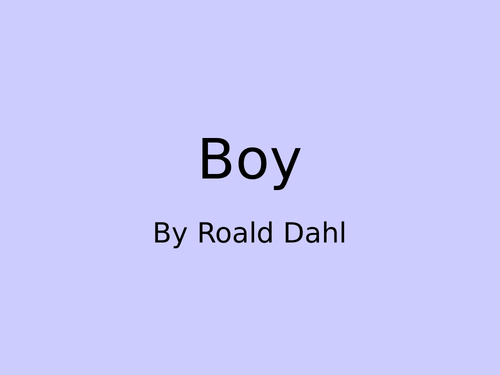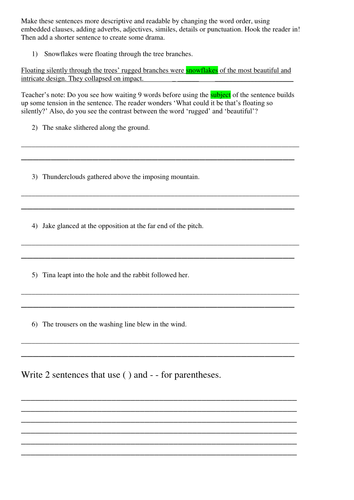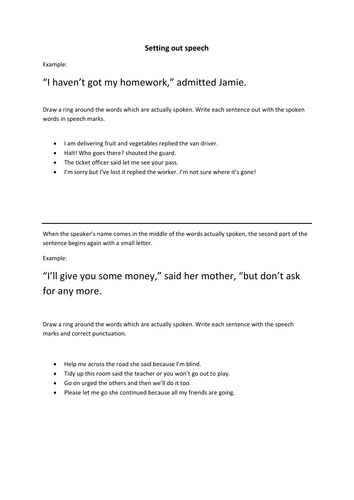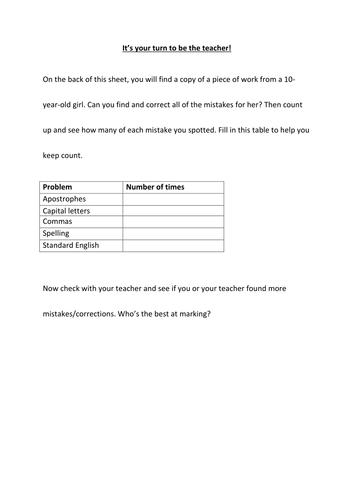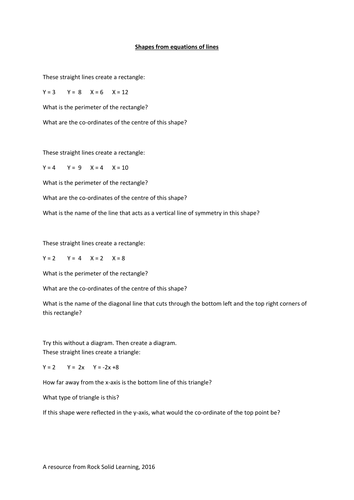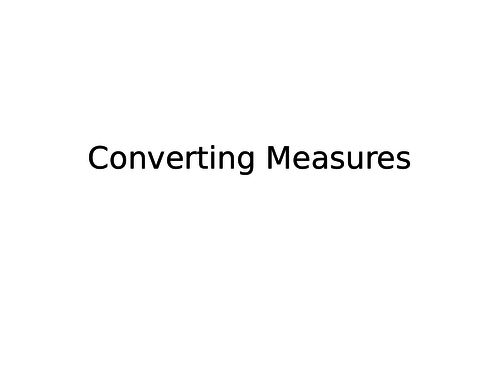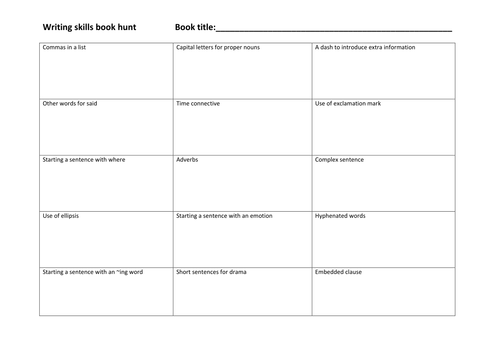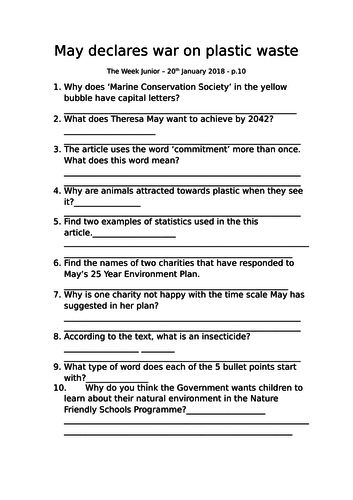46Uploads
40k+Views
16k+Downloads
All resources

Introducing and explaining column addition and its place value
This resource is designed for groups who are in the early stages of column addition. It is used a bit like a smartboard (although it's in word) as its examples need to be worked through with the children. Visually, the questions are shown with arrow cards to help show that adding 2 and 6 in the tens column is the same as adding 20 and 60. This also helps if you are then able to provide this resource children to use 'hands on' in the lesson. For questions that require carrying, the appropriate 10 or 100 is available at the bottom of the page to drag up in to the questions. The first questions are TU + TU with no carrying, reaching HTU + HTU with carrying by the end.

Addition and subtraction with negative numbers in the context of temperature
Here we have three resources. The first is a number line from -20 to +20 which will help pupils to complete the two activities.
The first activity asks pupils to increase or decrease a temperature by a given amount of degrees. Blue and red are used to help colour co-ordinate the questions depending on whether the temperature rises or drops. Later questions involve a temperature that first goes up and then comes down a bit, providing a basic two-stage question.
The second activity requires the pupils to do multiple increases or decreases (or both) to get a final temperature. For example: It's 11 degrees and the temperature drops by 2 degrees every night for six nights. It them increases by 3 degrees for one further night. What's the final temperature?

Making and proving statements using shapes and properties of shapes
The main activity in this lesson begins with asking children to make some true statements about a group of shapes (where the statement will be true for ALL shapes in that group).
From here the activity moves on to looking at a statement about a shape and seeing if children can find an example of a shape which proves this statement and another shape that disproves the statement. A sheet of shapes has been provided so children don't always have to draw shapes but can cut and stick instead.
This resource also comes with 3 introduction or follow up activities linked to shapes and their properties. There are instructions for drawing shapes with given properties; a Carroll diagram for sorting right angles and curved sides, and a table looking for the basic sides and corners of well-known 2D shapes.

Simile matching and writing activity
This resource allows for work on eight sentences of similes, using 'like', 'as' and 'as if'.
It is a cut, match and stick activity.
The first five sentences require the children to match the starts and ends of sentences, with pictures to try and help them see the connections.
The last three sentences have the starts of the sentences and blank boxes for them to create their own endings, with enough room to draw a picture to help show the comparison.
Images have been labelled as appropriate for reuse via the advanced search of Google images.

Boy by Roald Dahl - questions, discussions and activities by chapter
Aimed at upper KS2 or KS3 readers, this resource provides a way to help students engage with the text. With 25 slides (one per chapter), it helps teachers to plan discussions and activities relating to each chapter. Some may be questions you want to ask along the way as you are reading as a class (or alternatively could be modified into comprehension task questions); other activities could be developed into a whole lesson (e.g. a piece of writing or a class debate).
There are a variety of tasks and questions around different topics and reading skills:
formal/informal language
standard/non-standard English
predictions
looking up vocabulary
author’s language choices
structural techniques such as short sentences and use of repetition
building up suspense
author’s awareness of the reader
author’s purpose in writing
This resource also aims to engage pupils in the text through:
drawing characters and settings
comparing what is recorded in the book with their own experiences
generating deeper discussion about schools, traditions and punishments
encouraging students to look up things on the internet: maps, photos, youtube clips

Uplevelling writing and word order for more able writers. Colons and Semi-colons.
I used this for homework for more able Year 5 and Year 6 pupils.
The first page is about taking ordinary sentences and making them more interesting by looking at word order for creating tension or excitement, and then following them with shorter sentences for contrast and drama.
The second page looks at the uses of colons and semi-colons, modelling examples before asking the children to write their own.

Speech punctuation (inverted commas, setting out speech)
This resource, over two pages, has four activities increasing in difficulty. The first two give the pupils sentences in which they need to identify and circle the actual spoken words. Having done this, they can attempt to write out the sentences in their books with the correct punctuation. A modeled example is given.
The third activity asks the children to insert the punctuation on the sheet for a five-line conversation.
The final activity is a conversation between two characters. The one character has all of his lines already written on the sheet. The second character's responses need to be written by the pupils.

Editing for punctuation and spelling (marking, checking work, improving work)
In this activity, the pupil is challenged to act as the teacher and mark a piece of work. The text is a well-spaced A4 recount with a number of spelling and punctuation errors, including commas for lists and clauses, capital letters and homophone spelling mistakes. There is an answer sheet too.

Shapes and co-ordinates from equations of lines
This resource provides pupils with equations of lines (e.g. y = 8, y = 4...) that will form a basic shape on a grid. Questions then ask for the perimeter of the shape or the co-ordinates at the centre of the shape. It is good to encourage pupils to find a way of answering these questions without drawing accurate graphs every time but perhaps just little sketches or by looking at the appropriate numbers.
The fourth and final question uses the equations of straight lines to form a triangle with questions asking about the type of triangle and a new co-ordinate if the shape were reflected in the axis.

Fractions problem solving
Based on a GCSE exam question, this worksheet has four examples of tables that need filling in. Answers are provided and a helpful hints box at the bottom helps pupils to get started if needed.

What algebraic expressions mean
This is a good resource for pupils beginning in algebra, especially those who like to know exactly what's going on and why. The left hand column of the resource gives written examples showing that, for example, 3 x a x a can be written as 3a(squared). It proves this by working the same example through with numbers. 3 x 4 x 4 = 3 x 4(squared) = 48.
The right hand column requires the pupil to have a go at writing a simplified algebraic expression based on the pattern in the left column. There is room to do a 'numbers version' if that helps.
At the bottom, there is a challenge to work the idea backwards, expanding expressions such as 6fg to find out what's really going on inside that expression.

Structuring answers about writers' skills using Point, Evidence, Analysis
This resource comprises two sheets. The first shows a model answer about Sir Arthur Conan Doyle's descriptive writing skills in The Hound of the Baskervilles, beginning with a simple answer, moving to a more detailed answer and finishing with some extra detailed analysis.
The second sheet is made up of prompts for sentence starters on making a point, introducing evidence from the text and beginning to explain what it means.

Converting measure using lining up place value (rather than x/10,100,1000)
I made this resource when working with some weaker Year 6s who got in a massive muddle with converting cm, m and km. They couldn’t remember what to times and divide by, whether they were shifting the digits or decimal point (because different teachers had taught them differently!) or which way they were shifting things.
So this powerpoint/lesson avoids that method and uses the lining up method where they need to write down the conversion, then the question underneath and spot where 0s and decimal points need to go. E.g.:
1000m = 1.000km
0751m = 0.751km
The lesson starts with some warming up of place value and lining up decimal numbers.
It then moves on to look at units of measure and asks children to estimate some lengths, weights and volumes. (It seemed that my group had no idea what a ‘reasonable’ answer was, as they had no context of distance or weight.)
The powerpoint explains how to line up to find the answer.
Questions are provided and slides 26-29 should be printed for the independent worksheet.
All answers provided.
I appreciate children need to know the multiplying and dividing method for converting measure (see my other resources). This was a much-needed ‘quick-fix’ for SATs preparation. Please do make sure you go over the standard method with your class at a later date!

Writing skills book hunt (skimming and scanning looking for key skills)
In this activity, pupils need a fiction book to hunt for examples of authors using writing skills. Writing skills needed include those such as short sentences for drama, starting sentences in different ways and using different words for 'said'. It also asks them to find examples of ellipsis, exclamation marks, proper nouns, hyphenated words and commas in lists, among other things.
For each of the skills/examples required, there is an example given on the sheet to act as a model and to remind the pupils in case they have forgotten.

KS2 Maths daily warm ups, starters, mental orals
Suitable for upper KS2, these powerpoints each contain 10 slides: half with questions and half with answers. Each slide has an activity that is differentiated but easily edited to suit your needs. My recommendation would be to let the children choose which colour box to start on and, if they finish ahead of time, they can progress onto the next box.
This resource is ideal for revision of recently covered topics or for 'just keeping things ticking over'.
Week 1: Number
Week 2: Calculation

Fractional and negative indices matching cards and board game
I used this resource over two lessons.
In the first lesson we used the colour coded question cards to teach indices with increasing degrees of difficulty. The cards are coloured red, orange, yellow, green, blue and dark blue. With red having positive integer indices and orange having negative integer indices. As it works down through the colours, it introduces 1/2, -1/2, 3/4 and -3/4. There are five questions in each colour and the answers are available if you want to do it more as a matching exercise.
In the second lesson, I provided pupils with the prompt sheet of the 6 processes covered last lesson. With this as support (no exercise books allowed), we used the same question cards again to complete a board game in pairs. Instructions for the game are included, with suggestions for differentiation too. It went down very well, hence listing it here.

Homophones (4 activities with increasing difficulty)
Teaching homophones for an entire lesson is pretty hard work and the children get so overloaded with words that they can’t remember them all. So I created four smaller 10-20 minute activities to use as lesson starters or fillers to give children the words in smaller doses.
The first is a powerpoint, which would work best as a whole class with whiteboards. It asks if children know any different spellings for a given word and then uses pictures to support the teacher in giving definitions of the words.
The second is a matching activity (matching homophones to their definitions) that pupils could complete in pairs. These words are trickier and may require the children to use dictionaries.
The third activity is a gap fill, asking the children to choose the right homophone to complete the sentence. Again, dictionaries could be useful.
The final activity asks pupils to write their own sentences to show that they understand the different meanings of homophones. There is a points element that could help make this competitive if that’s the way you class works!
All activities meet NEW homophones; they are not repeated from previous activities.

Algebraic expression into words
A matching activity where pupils need to match an algebraic expression e.g. xy into words e.g x multiplied by y.

Reading Comprehension - The Week Junior - 20.01.18 - War on plastic waste
If your children read The Week Junior, get them to read the ‘May declares war on plastic waste’ article on p.10 in the 20th January 2018 edition. Follow it up with this quiz which is based mainly on reading comprehension skills. 10 questions. Great for morning work or guided reading.





